Introduction: A Farmer’s Struggle with Soil Quality
Ramesh, a smart farmer from Bihar, did everything right—timely sowing, regular watering, pest control. Still, his tomato yield flopped. Why? Acidic soil, low nitrogen—something he never checked.
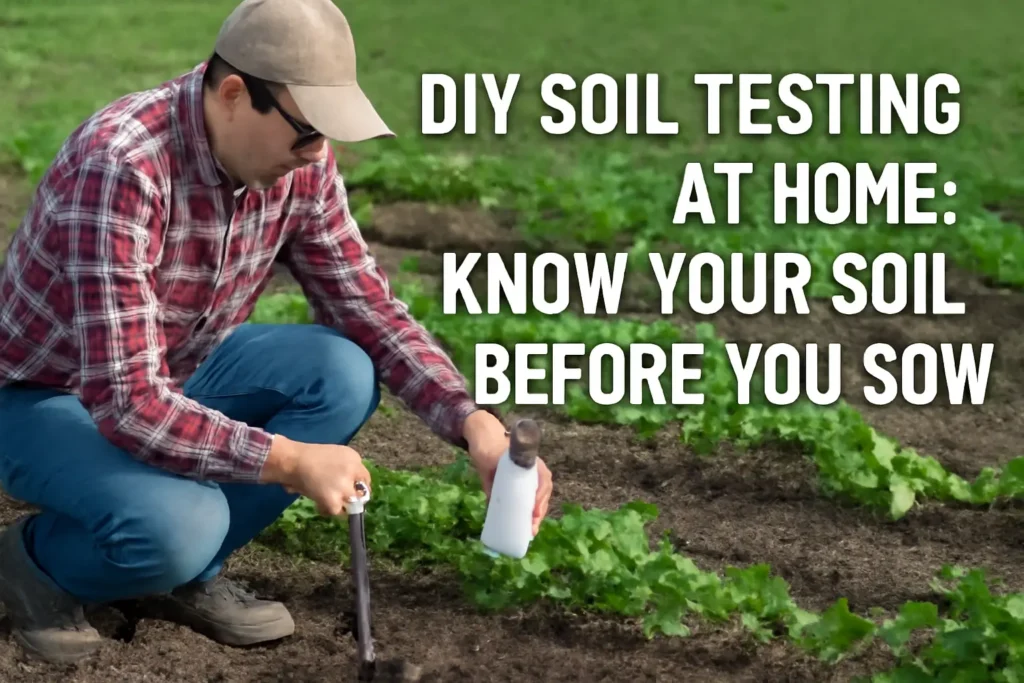
Let’s face it—farming without testing your soil is like driving with your eyes closed. And that is where the game changes.
You do not need a lab or a scientist. With a few simple tools and desi tricks, DIY Soil Testing at Home is totally doable—and super helpful.
In this article, I will show you how to check your soil yourself, why it is a must before sowing, and how it can literally save your entire crop season. If You are interested in organic farming, you can check my latest blog on this category learn farming in simple and interseting way.
What is Soil Testing – The Foundation of a Healthy Farm
Think of soil testing as a health report for your land. Just like you’d get a blood test before taking medicines, your soil needs a check-up before you sow.

Is your soil too acidic or alkaline? Is it rich in nitrogen, phosphorus, potassium (NPK)? Is it holding water well? Is it more sandy, clayey, or loamy? These little details matter a lot.
Because no two soils are the same—even fields next to each other can behave differently. Without testing, you are basically guessing—adding urea when there is already enough or growing a crop that does not suit your soil.
DIY Soil Testing Methods at Home: Tools, Steps & Scientific Explanation
| Test Method | What You Need | Scientific Explanation (Why It Works) |
|---|---|---|
| 1. pH Test with Vinegar & Baking Soda | a. 2 bowls of soil, b. Vinegar, c. baking soda, d. Water | Vinegar reacts with alkaline soil (carbonates), baking soda reacts with acidic soil (hydrogen ions). Fizz shows presence of acid or base. pH affects nutrient availability for plants. |
| 2. Jar Soil Texture Test | a. Mason/glass jar, b. Dry soil, c. Water, d. Dish detergent | Sand, silt, and clay settle at different rates due to their size. The layer pattern reveals soil type, which affects water retention, root penetration, and nutrient flow. |
| 3. Drainage Test | a. Shovel, b. Water, c. 1-foot-deep hole | Measures how fast water drains. Poor drainage = anaerobic conditions, killing microbes. Ideal drainage supports healthy roots and soil organisms. |
| 4. Earthworm Count Test | a. small spade, b. Measuring square (1×1 ft), c. Ruler or depth gauge | Earthworms indicate biological activity. They improve aeration, enhance microbial life, and their castings enrich soil fertility. No worms = poor organic matter or chemical imbalance. |
| 5. Plant Observation Method (Bonus) | a. Eyes & patience, b. Watch growth/yellowing/patterns of specific plants | Some plants show pH or nutrient imbalance (e.g., yellow leaves = nitrogen deficiency). Observing symptoms can guide nutrient correction, especially when combined with test results. |
| 6. DIY NPK Estimation Kit (Optional) | a. DIY NPK test kit (from agri stores), b. Water, c. Soil samples | These kits use chemical indicators that change color based on nutrient levels. It gives rough estimates of nitrogen, phosphorus, and potassium in soil for better fertilizer planning. |
How to Test Soil at Home (DIY)– Step-by-Step Guide for Indian Farmers & Gardeners
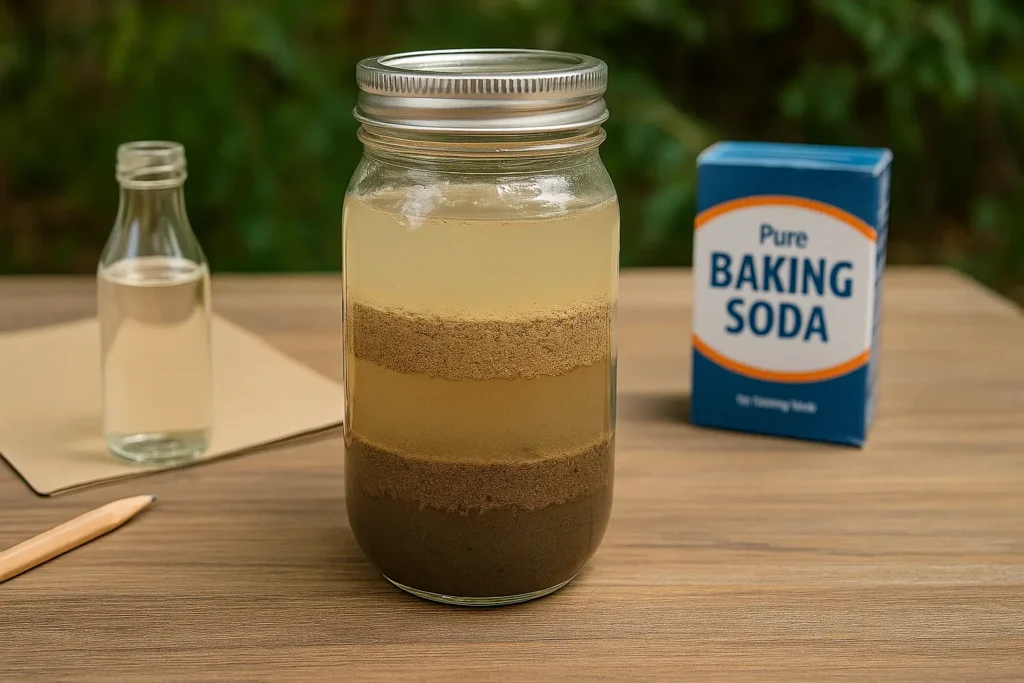
You do not need a fancy lab or expensive gadgets to understand your soil. With a few basic tools and a little know-how, you can perform DIY Soil Testing at Home and make smarter decisions for your crops. Let’s walk through it – desi style, step-by-step!
🥄 Step 1: Collecting the Soil Sample the Right Way
Before we even think about testing, we need to make sure we have the right soil sample — not just grabbing a handful from the surface and calling it a day!
what you need:
- A small shovel or spade
- A clean plastic bucket
- A plastic bag or any clean container to store the sample
How to do it properly:
1. First, do not just stick to one spot!
Move around your field or garden and pick 5 to 10 random spots — this way, you will get a more accurate reading of your overall soil health and hopefully perform well.
2. At each spot, dig about 4 to 6 inches deep.
That’s the layer where most of the roots are growing and feeding — and that’s what really matters for your crops.
3. Take a small handful of soil from each spot and toss it into your bucket.
Mix all the samples together nicely — like mixing ingredients for a good recipe!
4. Now, let this mixed soil dry in the shade.
(No direct sunlight — we don’t want to “cook” the nutrients out.)
5. Once it’s dry, store it in a clean plastic bag or container — ready to send it for testing.
Why this method?
Because one handful from here and another from their on the field balances out the natural differences across your field.
Instead of testing one “good” or “bad” patch, you get a real average of your soil’s condition — which means better advice, better fertilization, and better yields later on!
🌡️ Step 2: Testing Soil pH – Is Your Soil Acidic or Alkaline?
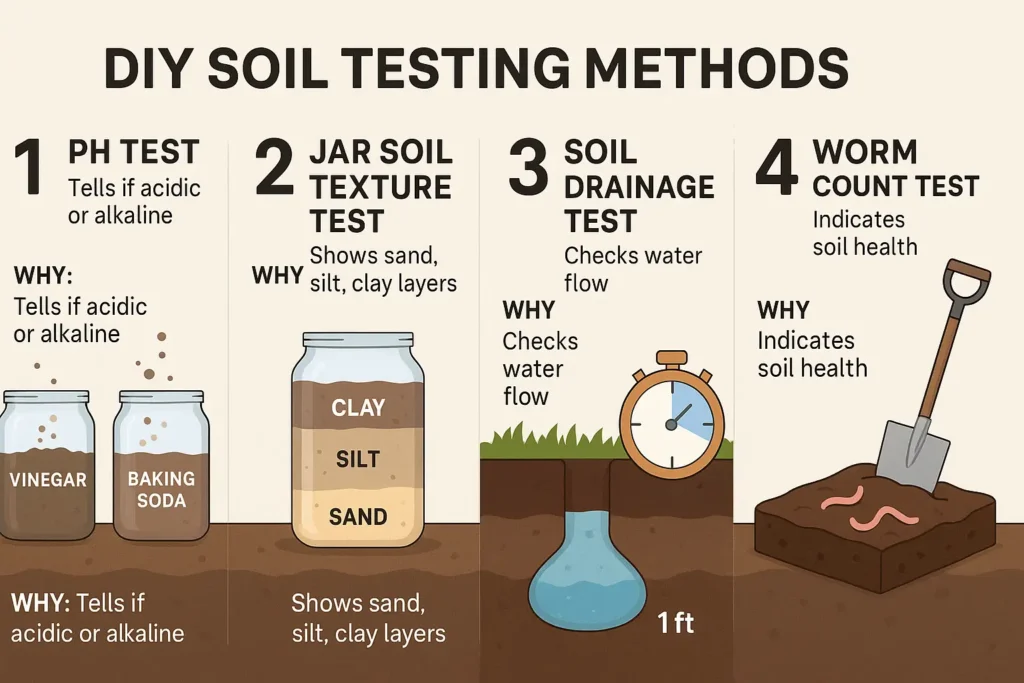
Now that you’ve collected a good soil sample, the next important thing is to check your soil’s pH level.
(Think of it like checking your soil’s “health report” — because pH decides how easily your plants can absorb nutrients!)
If your soil is too acidic or too alkaline, your crops might look healthy outside but struggle deep inside.
That’s why finding the right pH is mission critical before sowing anything.
You’ve got two simple ways to do it:
🔹 Option A: Using a pH Test Kit (Scientific Method)
✅ Take a little bit of your dry soil sample.
✅ Mix it with distilled water (normal tap water can mess up the result, so stick to distilled).
✅ Dip the pH strip or use the solution as per the instructions in your kit.
✅ After a few seconds, compare the color change with the chart provided in the kit.
👉 This will give you a pretty accurate pH value — usually between 4.5 to 8.5 for most soils.
🔹 Option B: Desi Jugaad Method (For a Quick Home Test)
(If you do not have a kit handy, no worries — your kitchen can help!)
✅ Take two small bowls of soil.
✅ In the first bowl, pour some vinegar on the soil:
- If it fizzes → Your soil is alkaline (high pH).
✅ In the second bowl, add water first and then baking soda:
- If it fizzes → Your soil is acidic (low pH).
✅ No fizz in either?
- Congratulations! Your soil is neutral, which is the sweet spot for most crops like wheat, vegetables, and fruits.
👉 Why does this matter?
Because at the wrong pH, even if you add the best fertilizers, plants cannot absorb nutrients properly.
Correcting soil pH at the start can literally save you thousands of rupees in fertilizers and increase your yields dramatically!
🌾 Step 3: Checking Soil Nutrients – Nitrogen, Phosphorus, and Potassium (NPK)
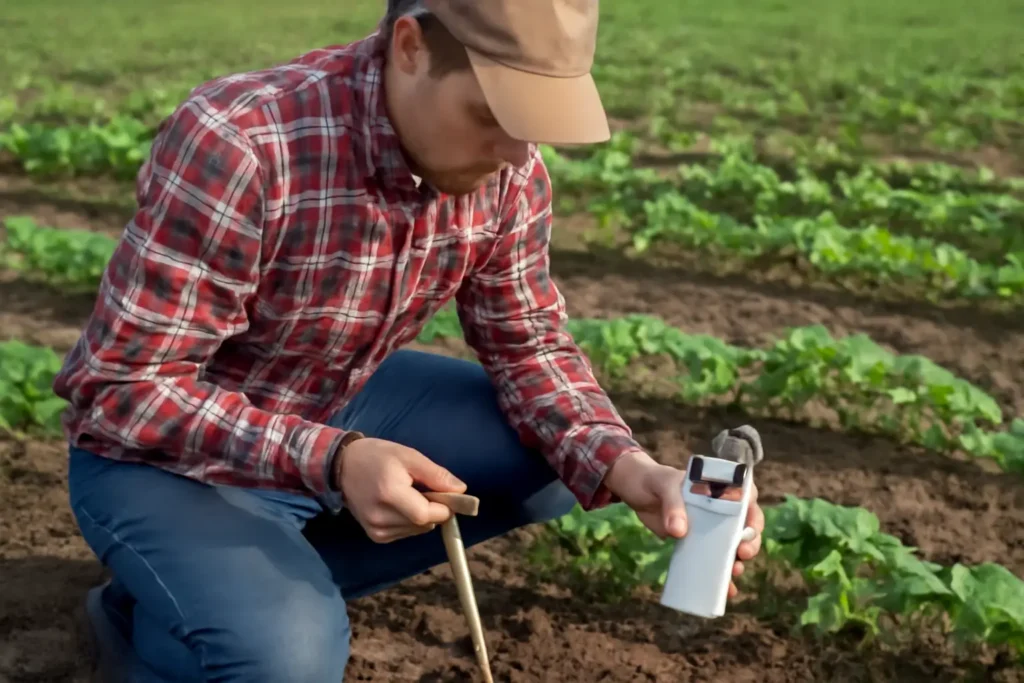
Once your soil’s pH is understood, it is time to check for the big three nutrients:
Nitrogen (N), Phosphorus (P), and Potassium (K).
Think of them as your soil’s energy drink — if even one is missing or too low, your plants will not grow properly, no matter how good the seeds are!
🔹 What You will Need:
✅ A simple soil nutrient testing kit — easily available at local agri shops or even online stores like flipkart and amazon.
I recommend you try to pick a kit that gives separate readings for Nitrogen, Phosphorus, and Potassium individually.
🔹 How to Do It:
✅ Take a small amount of your prepared soil sample.
✅ Mix it with the chemical solution provided in the kit — follow the instructions carefully (different tests for N, P, and K).
✅ After a few minutes, you’ll see a color change in the solution.
✅ Compare the color against the kit’s chart to find out if each nutrient is Low, Medium, or High in your soil.
Why This Step Matters:
When you know your NPK status, you can make a customized fertilizer plan.
This leads to higher yields, healthier crops, and long-term soil sustainability — something every smart farmer should aim for.
🌱 Step 4: Soil Texture Test – Sand, Silt, or Clay?
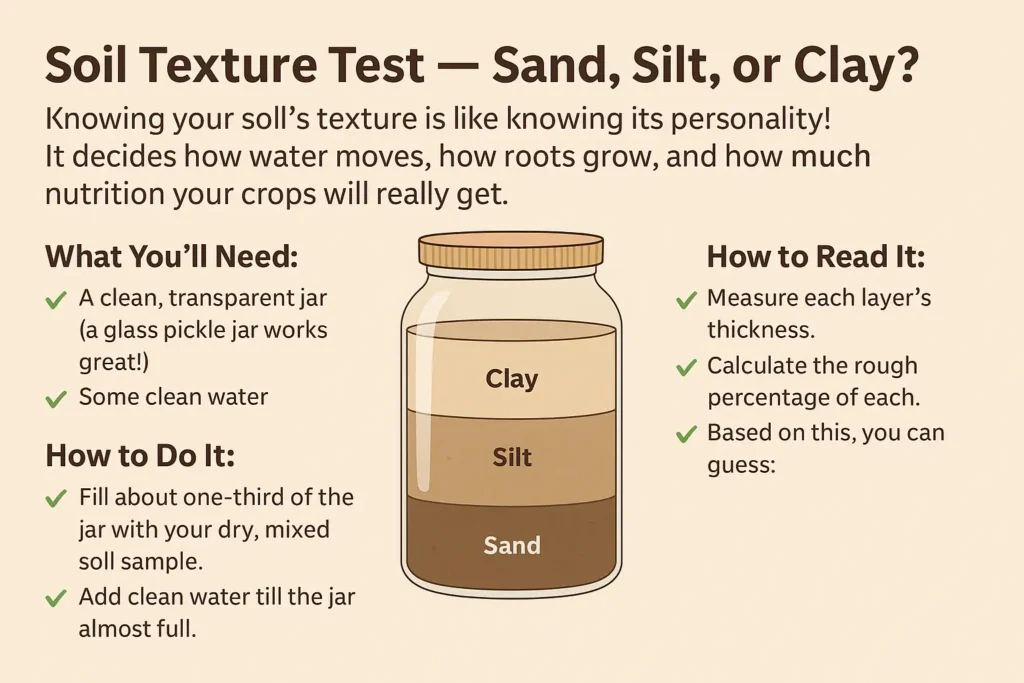
Knowing your soil’s texture is like knowing its personality!
It decides how water moves, how roots grow, and how much nutrition your crops will really get.
Loamy soil — a perfect mix of sand, silt, and clay — is considered the gold standard for most farming.
🔹 What You will Need:
✅ A clean, transparent jar (a glass pickle jar works great!)
✅ Some clean water
✅ A small pinch of detergent or liquid soap
🔹 How to Do It:
✅ Fill about one-third of the jar with your dry, mixed soil sample.
✅ Add clean water till the jar is almost full.
✅ Add a small pinch of detergent — this helps the soil particles separate better.
✅ Now, shake the jar vigorously for about 1–2 minutes — jaise achha sa lassi banate ho waise! 😄
✅ Keep the jar aside undisturbed for 24 hours.
After 24 hours, you will notice clear layers forming:
- Sand settles at the bottom (it is the heaviest).
- Silt forms the middle layer.
- Clay floats to the top (because it’s the lightest and finest).
🔹 How to Read It:
✅ Measure each layer’s thickness.
✅ Calculate the rough percentage of each.
✅ Based on this, you can guess:
| Dominant Layer | Your Soil Type |
|---|---|
| Mostly Sand | Sandy Soil (Drains fast, poor nutrient holding) |
| Mostly Silt | Silty Soil (Fertile but can compact easily) |
| Mostly Clay | Clayey Soil (Holds water but poor drainage) |
| Balanced | Loamy Soil (Perfect for most crops) |
💡 Desi Kisan Tip:
Good farmers know that loamy soils hold water and drain excess properly — meaning less waterlogging, better germination, and stronger roots.
If your soil is too sandy or too clayey, simple improvements like adding compost or organic matter can fix it over time!
👉 Why This Step is Important:
Before sowing seeds or planning fertilizers, understanding texture helps you decide what crops will thrive and how to manage irrigation smartly.
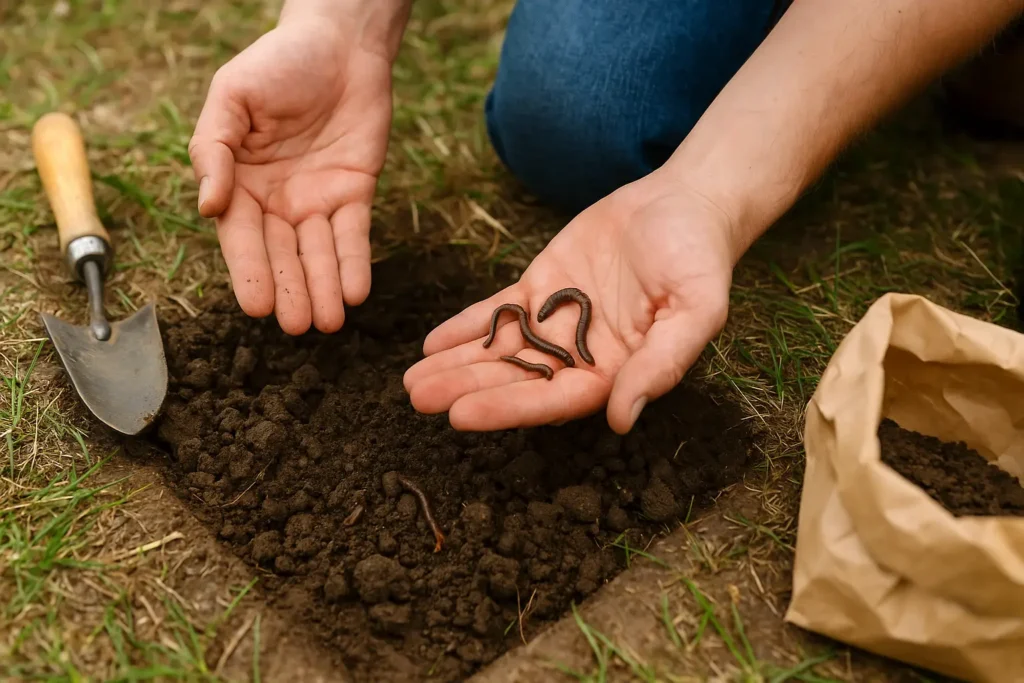
🌱 Step 5: Earthworm Count – Is Your Soil Truly Alive?
If soil is the body of farming, earthworms are its heartbeat.
No fancy tools needed here — just your eyes, your hands, and a little patience.
Earthworms are nature’s own tillers.
They aerate the soil, improve water movement, and leave behind nutrient-rich castings (worm poop = natural fertilizer!).
🔹 What You will Need:
✅ A small digging tool (like a spade or khurpi)
✅ Your own eyes and hands!
🔹 How to Do It:
✅ Pick a random spot in your field or garden.
✅ Mark out a small 1-foot by 1-foot square on the ground (approx. 30cm x 30cm).
✅ Dig about 6 inches deep into the soil.
✅ Gently break apart the dug soil with your hands and start counting the earthworms you find.
🔹 How to Read It:
| Number of Earthworms | Soil Health |
|---|---|
| 10 or more worms | Excellent! Your soil is teeming with life. |
| 5–10 worms | Fair. You’re on the right track, but can improve. |
| Less than 5 worms | Warning! Your soil may need more organic matter and care. |
Here you can compare result: If you find less than 5 worms, it’s a clear signal —
your soil might be low in organic carbon, microbial activity, or has been over-tilled or over-chemicalized.
✅ Quick Fix: Add vermicompost, cow dung manure, or start mulching to bring life back into your soil.
👉 Why This Step is Powerful:
Many modern soil tests miss the biological health part.
Earthworm count is the simplest, most old-school trusted method to know if your soil is truly living — just like a KVK expert or progressive farmer would do.
📝 Step 6: Record, Reflect, and Respond – Make Your Soil Testing Truly Useful
Testing your soil is not just a one-time “done it” job —
the real magic happens when you note it down, think about it, and take smart action.
🔹 What You Should Do Next:
✅ Grab a notebook or open an Excel sheet on your phone/laptop.
✅ Carefully write down all your test results:
- pH level
- Nutrient status (N, P, K)
- Soil texture (sand, silt, clay mix)
- Earthworm count
✅ Now reflect on what your results mean:
- Is the pH too acidic? Maybe you need to add lime.
- Low nitrogen? Time to plan some compost or urea.
- Heavy clay soil? You might need organic matter to loosen it up.
- Few earthworms? More vermicompost and less chemical sprays needed.
🔹 Pro Farmer Tip:
Combine your DIY results with your government-issued Soil Health Card (from your nearest KVK or agriculture department).
This way, you double-check your observations and get even better recommendations for fertilizer use and soil improvement.
Why This Step is Important:
| Action | Benefit |
|---|---|
| Recording | You don’t forget small but important details. |
| Reflecting | You understand the real needs of your soil. |
| Responding | You take the right action at the right time – saving money, improving yield. |
Kisan Smartness:
Soil health is not static. Conditions change season by season.
Recording today will help you compare year on year and track if your soil is improving!
Common Soil Testing Mistakes & Myths – And How to Fix Them

| Problem | Mistake / Myth | Solution / Fact |
|---|---|---|
| Wrong test readings | Testing wet soil (mistake) | Always test with dry, crumbly soil for accurate results. |
| Misinterpretation | No baseline data to compare results (mistake) | Refer to your local KVK or agri department’s soil guidelines. |
| Incomplete diagnosis | Only checking pH, ignoring texture or drainage | Test for pH and other key factors like texture, drainage, and worm activity. |
| One-time effort | Belief: “You only need to test soil once.” | Test soil every year or two – weather & crops change the soil profile. |
| Scale misconception | Myth: “Soil testing is only for big farms.” | Small farms or kitchen gardens benefit equally. |
| Fear of complexity | Myth: “Soil testing is too complicated or costly.” | DIY tests are easy, cheap, and reliable. |
| Inconsistent results | Relying on one-time test without seasonal follow-ups | Re-test soil at least once a season for better decision-making. |
Soil Testing Benefits: Data-Driven Insights
- Higher Yields: Research from FAO shows that regular soil testing can boost crop yields by 15–25%. Better soil health and also helpful for crops.
- Cost Savings: NABARD reports indicate that proper soil diagnosis before sowing can reduce fertilizer costs by up to ₹3,000 per acre.
- Balanced Nutrition: ICAR recommends testing soil every 3 years to maintain balanced soil nutrition, ensuring your crops get the nutrients they need.
- Environmental Benefits: Proper soil care reduces pollution and promotes eco-friendly farming practices, protecting the environment.
- Healthier Plants: Healthy soil means healthier crops, more resistant to pests, diseases, and climate change. The right pH and nutrients make all the difference.
Success Stories: Farmers Transforming Their Yields with Soil Testing
A Farmer Raj from Uttar Pradesh and Sunil from Maharashtra both experienced struggles with their crops – but both turned things around by simply testing their soil.
Raj, a rice farmer, had always struggled with poor yields, despite regular fertilizer application. After testing his soil’s pH, he discovered that his soil was highly acidic. Armed with this knowledge, he added lime to adjust the pH. Within months, his crops grew stronger, and his yield shot up by over 25%.
Meanwhile, Sunil from Nashik found his soil was also acidic after testing it with a simple DIY method. Instead of growing onions, which don’t thrive in acidic soils, he decided to neutralize the pH with lime and switched to growing marigolds. The result? His income jumped by ₹40,000 that season, all thanks to understanding his soil’s needs.
These stories prove that a little soil knowledge can go a long way in transforming farm productivity.
Conclusion: Test Your Soil, Rule Your Farm!
Soil testing is not rocket science — it’s desi jugaad meets smart farming! Whether you have a giant field or a cozy kitchen garden, knowing your soil’s mood is the real shortcut to better crops, more profits, and eco-friendly farming.
With simple things like a jar, vinegar and little bit field work. you can decode what your soil really wants — as a like doctor analyse the patient’s report.
Remember this — understanding your soil before sowing is the ultimate game-changer. Test your soil today, and tomorrow you’ll rule over lush green fields!
👉 Call to Action:
If you’re dreaming of making your farm organic and sustainable, make soil testing the hero of your farming routine — starting today!”
✅ Also, don’t miss our Organic Farming category — a must-read for every new-age farmer.
And yes, stay connected with Agriverses — where desi storytelling, comic-style fun, and science-backed farming tips come together to teach you agriculture in a whole new way!
“Listen, Learn, and Befriend Your Soil — the Desi Way!
Frequently Asked Questions (FAQs) – Soil Testing and Fertility
How often should I test my soil for the best results?
It’s recommended to test your soil every 1-2 years, especially when changing crops, fertilizers, or irrigation methods. Regular soil testing ensures optimal crop growth and efficient use of fertilizers.
Can I test soil for multiple crops at once?
Yes, you can test soil for all crops in one go. However, if you plan to grow different crops with varying nutrient needs, it’s best to conduct separate tests to tailor your amendments to each crop’s requirements.
Are home DIY soil testing kits accurate?
DIY soil testing kits are generally accurate for checking pH and basic nutrient levels (NPK). For more precise results, including micronutrient analysis, you can send soil samples to a professional lab or your local Krishi Vigyan Kendra.
What is the cheapest way to test soil?
The most affordable way to test soil is using a DIY soil testing kit or conducting simple at-home tests like pH testing with vinegar and baking soda. These methods provide useful insights without the expense of lab testing.
How to check pH of soil at home?
To check soil pH at home, mix a small soil sample with distilled water and use a pH testing kit, or use the simple vinegar and baking soda method to get an estimate of the pH level.






